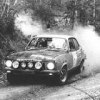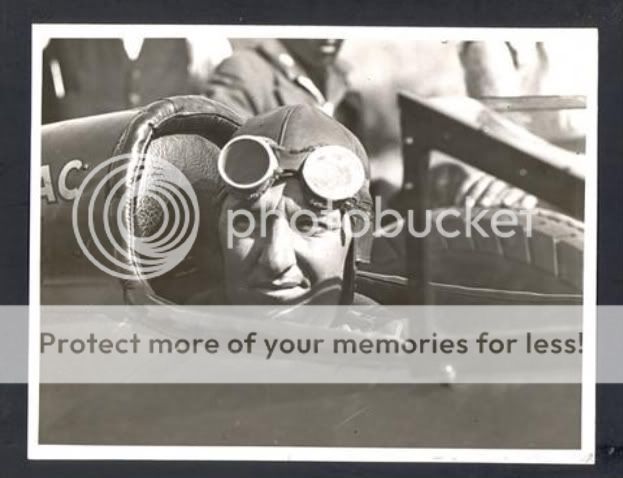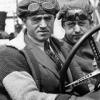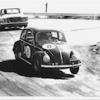
Norman 'Wizard' Smith
#1

Posted 12 June 2008 - 10:08
Advertisement
#2

Posted 12 June 2008 - 12:28
There's a bit in a 1983 book called Flat to the Boards - email or PM me if you want more
#3

Posted 15 June 2008 - 22:30
PS I may still have the "Wheels" but it would take some time to find it
#4

Posted 15 June 2008 - 22:41
http://www.naa.gov.a...6/april-01.aspx
And a story here
http://www.nectarbro...cars/page4.html
and here
http://www.buickclub...0/ContentID/343
and here
http://www.adb.onlin...gs/A110677b.htm
and an interesting bit here
http://sites.archive...2006/april.aspx
hope this helps . I can try and find more , or someting specific if you'd like . Don't know of any print info , if that's what your after though .
#5

Posted 16 June 2008 - 09:38
I assumed the trouble I had researching Smith and his land speed attempt, was simply the distance between the UK and New Zealand, but there was very little on the man, or his machines, although one guy I did speak to kept using the words "he was a wizard with metal" and "genius"!!
#6

Posted 16 June 2008 - 19:33
Originally posted by Huddy55
In November 1923, a record run was set from Adelaide to Mebourne by Norman Smith(Wizard Smith) of 13 hours and 21 minutes. 1 1/2 hours quicker then the previous record.
On stages of this run the Essex was clocked at 100mph. Travelling via Coorang in South Australia, Smith hit an emu. The impact holed the radiator and smashed the windscreen. The screen was repaired in Hamilton but the leaking radiator cost time in refilling. After leaving Hamilton a nut came of the carburettor bowl and Wizard's mechanic, Len Emmerson, spent a number of miles lying alongside the bonnet holding the bowl in place. With the nut replaced, the pair found thier spare tyres had fallen off. A back track of 17 miles was nessary to retrieve them.
Presumably it was this run that prompted a prominent Melbournian to purchase a Roamer Duesenberg in an effort to take the honours from Smith. Experimental tyres ruined his run, however. This car is now in Ivan Saxton's collection.
It's also interesting that Smith still holds some official intercity records... they having been banned in 1935. Prior to that time drivers circumvented speed limits by getting official military communiques and conveying the between the cities involved.
#7

Posted 18 June 2008 - 11:21
#8

Posted 18 June 2008 - 11:45
#9

Posted 18 June 2008 - 13:47
Originally posted by Steve L
Any idea what happened to Smith's Enterprise, Steve?
I wish! It's a bit like Silver Bullet, it just seems to have vanished. I recall seeing a colour rendition of Enterprise, and it looked like it had been taken years after the Ninety Mile Beach attempt, red in colour, not the best of angles, so she did last for some time after, the trail went cold in 1950 something............
#10

Posted 18 June 2008 - 22:33
Barry Lake's "Half a Century of Speed" contains some useful photos of Smith and some of his cars, including both LSR cars
#11

Posted 19 June 2008 - 09:24
Originally posted by john medley
After the dispute between Wizard Smith and Don Harkness, the engine went back to its original supplier and my understanding is that Harkness retained the rest of the car. I was led to believe that the car was progressively dismantled and the chassis ended up under newly laid concrete at either Five Dock( location of Harkness' business) or Carlingford(near where Harkness lived), both suburbs of Sydney
Barry Lake's "Half a Century of Speed" contains some useful photos of Smith and some of his cars, including both LSR cars
What was the dispute between Smith and Don Harkness?
#12

Posted 19 June 2008 - 21:46
I no longer own a copy of the Steve Smith book but I guess the story is told there. Norman Harwood,then curator of the old Harris Street museum and a friend of Harkness', told me the story and showed me through a lot of Harkness stuff bequeathed to the museum. Harkness had many admirers. The whole thing was a pretty sad affair :I probably need to know more about it, but I dont really want to -- if you know what I mean
#13

Posted 20 June 2008 - 11:11
Regards, Lindsay Ross
#14

Posted 14 July 2008 - 10:43

#16

Posted 20 June 2011 - 17:34
#17

Posted 21 June 2011 - 08:33
I guess they had an ice tank in there somewhere but you wonder where on earth they could have fitted it!
Wherever it was there obviously wasn't the capacity to do the job in this form.
It is a truly fascinating car, all the more so for the lack of widely available detail.
#18

Posted 21 June 2011 - 10:04
In 1929 Norman 'Wizard' Smith and some other motoring people paid the lake a visit and made some runs in road cars on a specially prepared test track and plans were being made to grade a track for speed record attempts.
According to the newspapers Malcolm Campbell was being invited to use the lake after his troubles at Verneukpan. The papers report favourable letters from Campbell over the next couple of years.
In November 1933, the stories in the papers were problems with the leaseholders of the lake, the farmers (actually graziers) leasing the land opposed the plans for the Speedway on their land.
A letter to a paper posed the possibility of flooding but according to another story from one of the early climate scientists of the day the lake was going to stay dry forever as the water tables had dropped permanently due to to overuse of water by farmers.
In December 1933 the newspapers were still reporting the plans of the "speedway"
In January 1934 the lake was full of water.
#19

Posted 25 June 2011 - 08:57


Advertisement
#20

Posted 25 June 2011 - 14:56
#21

Posted 25 June 2011 - 19:26
DCN
#22

Posted 25 June 2011 - 21:24
Tremendous stuff, and it suggests that there must be more somewhere.
#23

Posted 25 June 2011 - 22:14
#24

Posted 26 June 2011 - 02:35
Smith was supposed to be opposed to the use of the chemical cooling chemical cooling system and wanted to use a plain ordinary water radiator. When the car arrived in NZ and Harkness had to rush back home to Sydney for business Smith decided to get a radiator made in NZ for the car.
#25

Posted 26 June 2011 - 10:34






#26

Posted 26 June 2011 - 10:57
What a monster, hard to believe it's not better known...
#27

Posted 26 June 2011 - 13:54
#28

Posted 26 June 2011 - 14:11
http://find.natlib.g.....28Timeframes)
http://find.natlib.g...tab=default_tab
#29

Posted 26 June 2011 - 14:29
#30

Posted 26 June 2011 - 16:19
#31

Posted 27 June 2011 - 08:07
#32

Posted 27 June 2011 - 08:13
No, a V12 Rolls-Royce
There appear to be three separate banks on cylinders in characteristic 'broad arrow' style...
#33

Posted 27 June 2011 - 08:34
http://www.flickr.co...57623444749654/
http://www.flickr.co...57623444749654/
http://www.flickr.co...57623444749654/
http://www.flickr.co...57623444749654/
Edited by Catalina Park, 27 June 2011 - 08:37.
#34

Posted 27 June 2011 - 08:40
#36

Posted 27 June 2011 - 08:48
#37

Posted 27 June 2011 - 09:07
http://www.gregwapli...enterprise.htmlThere appear to be three separate banks on cylinders in characteristic 'broad arrow' style...
#38

Posted 27 June 2011 - 09:58
#39

Posted 27 June 2011 - 10:04
Don't read the text. Just look at the photos. The photos don't lie.So it was a Napier Lion. What threw me was how far forward in the chassis it's mounted, and the "open bonnet" shot would only pick up the very rear of the engine. A peculiar weight distribution when one considers wheelspin was the frequent common enemy of most land speed cars. Having said that, the text makes reference to a Rolls-Royce engine, so maybe they tried both? Another buried car!!!
Advertisement
#40

Posted 27 June 2011 - 12:15
#41

Posted 27 June 2011 - 21:49
DCN
Edited by Doug Nye, 28 June 2011 - 04:08.
#42

Posted 28 June 2011 - 11:37
Superb photographs again. Some years ago I flew along Ninety Mile Beach south to north at about 500 feet and maybe 80-100kts, and what struck me most was the frequency with which it appeared to be crossed by waterways emerging from between the dunes to reach the sea. It must have been quite a conundrum to select a suffiiciently long and firm section for an LSR attempt. I can't help thinking that Wizard and poor old Fred would have been better advised to seek out one of the dry lakes or salt flats back home in Oz, rather than make the abortive and costly trip to New Zillan. At one point on our flight we overtook a bus, charging along the beach in a flurry of wet sand, every so often surfing through standing water or across a waterway, each of them perhaps only an inch or two deep. It was going well, and I recall at the time thinking how the Harkness car must have looked from such an aerial viewpoint - pretty darned spectacular I should think... Having driven a Napier Lion-engined car I have a pretty shrewd idea of how it would have sounded, and felt, from the hot seat, and from Wizard's viewpoint in that cockpit I am confident that the entire experience probably looked (and felt) simply horrible.
DCN
From a practical viewpoint, there may have been little to choose between 90-Mile Beach and the South Aust 'dry' lakes.
Access may have been better to 90-Mile Beach. The car was shipped from Sydney to Auckland, thence to Awanui on a 2-masted sailing scow(with auxiliary engine), and then by road and beach about 30 kms to their base at Hukatere. There is a photo on www.nzlib.govt.nz entitled "Racing Car Enterprise being unloaded at Awanui North". The haul from Sydney to Port Augusta, say, might well have been easier by boat than by road in 1930, and from there was a considerable distance to whichever lake/ salt pan was to be used. While 90-Mile Beach was subject to subject to 'rogue waves' sometimes, the tide went out, and the beach was often OK the next day. The dry lakes, like the Bonneville Salt Flats, were subject to occasional heavy rains and flooding which rendered them useless for weeks after.
There is further information on Wizard Smith's 1930 and 1932 efforts in "Flat To The Boards" by A.R.E.Messenger and Douglas E.Wood (1985 - Vintage CC of NZ) which has a quite detailed appendix on the topic, commencing with the following comment : "A lot of nonsense has been written by various authors on Norman Smith's accomplishments and accordingly it is gratifying to find that Dick Messenger, who was present at some' if not all of Smith's record attempts, has recorded the following summary for posterity."
#43

Posted 30 June 2011 - 10:30



#44

Posted 04 August 2015 - 01:21
I just ordered a new book on Smith written by Clinton Walker. Hopefully a good read
#45

Posted 04 August 2015 - 01:42
It is...and some good photos, too. ![]()
#46

Posted 04 August 2015 - 06:23
From a practical viewpoint, there may have been little to choose between 90-Mile Beach and the South Aust 'dry' lakes.
Access may have been better to 90-Mile Beach. The car was shipped from Sydney to Auckland, thence to Awanui on a 2-masted sailing scow(with auxiliary engine), and then by road and beach about 30 kms to their base at Hukatere. There is a photo on www.nzlib.govt.nz entitled "Racing Car Enterprise being unloaded at Awanui North". The haul from Sydney to Port Augusta, say, might well have been easier by boat than by road in 1930, and from there was a considerable distance to whichever lake/ salt pan was to be used. While 90-Mile Beach was subject to subject to 'rogue waves' sometimes, the tide went out, and the beach was often OK the next day. The dry lakes, like the Bonneville Salt Flats, were subject to occasional heavy rains and flooding which rendered them useless for weeks after.
There is further information on Wizard Smith's 1930 and 1932 efforts in "Flat To The Boards" by A.R.E.Messenger and Douglas E.Wood (1985 - Vintage CC of NZ) which has a quite detailed appendix on the topic, commencing with the following comment : "A lot of nonsense has been written by various authors on Norman Smith's accomplishments and accordingly it is gratifying to find that Dick Messenger, who was present at some' if not all of Smith's record attempts, has recorded the following summary for posterity."
There was a train line [the famous Ghan line] from Adelaide to Marree about 20k from Muloorina Station and the rail actually went past the lake higher up about 200m from the lakes edge.
I was always surprised that the Campbell attempt was carried there on a truck. The roads were there but all fairly rough in parts in those days
#47

Posted 04 August 2015 - 10:27
If I know anything about Donald Campbell and his record attempts, it would be because the railway were charging and the truck was free....................................
#48

Posted 04 August 2015 - 10:27
Was Don Harkness workshop on Parramatta Rd Five Dock or Victoria Rd Drummoyne?
#49

Posted 04 August 2015 - 11:22
Originally posted by f1steveuk
If I know anything about Donald Campbell and his record attempts, it would be because the railway were charging and the truck was free.....
Just as likely there was no way of unloading from the flatcars out there...
And a truck was most probably still required to get it the last few miles.
#50

Posted 04 August 2015 - 23:37
Aaah. Marree had platforms, cranes and all mod cons. In Campbells time there was a general carrier in town. Bloke called Tom Kruse who had quite a few large trucks. eg semis!
Marree was a major rail head, it was responsible for huge amounts of freight in and out. Handling a pommy speed event car would have held few problems, and they could have carried the truck there too. Or better just get Tom to transport it there. Many trucks and vehicles were carried there and away every train. To a large degree this is how the SA outback was developed. Lots of cattle [ or sheep] stations larger than European countries on both the Birdsville and Oodnadatta yet alone Strezlecki tracks.
The whole object of a heavy[ for the time] goods rail line. These days the roads are far better but the [far more modern] trucks bugger up the roads with motony.
And remember the line went to Oodnadatta at the turn of the century. The infrastructure was huge for the period with the line, sidings with platforms, water tanks and bores and water purifying plants. Boilers do not like bore water. [Great Artesian Basin]

 to feed them. The Ghan line had the longest bridge in the southern hemisphere at the time. Which is still standing.
to feed them. The Ghan line had the longest bridge in the southern hemisphere at the time. Which is still standing.
I have visited a few times and unfortunatly the infrastructure now is decaying and disappearing fast. I have heard one of the water plants has fallen down recently and all the water tanks are rusted out. [A few have disapeared as scrap in the past, as has nearly all the line] And the floods in the last few years have washed out a lot of culverts and small bridges. I suspect if the lines had remained on them they may have stayed put. But the line was abandoned so of no further use except for tourists to look at. Man makes and nature destroys. That line was in action until 1980. My father went on the final train, took the car with him as many tourists did in the time. really what is left some sidings are actively preserved/ maintained as even are the water plants but the air and termites just kill everything.
From memory the line was extended to Alice during the war. Oodnadatta was the end prior to that. And the road, the telegraph followed the rail line.
The current line is a long way west of this line. As is the main bitumen highway. And the phone lines too.
Really to call it the Ghan is misleading. The Afghans and their camels used the old route as that is where the people were. And Traders/ carriers need people. And the two lines seperate at Pt Augusta and join again in Alice.
I suggest for anyone interested google the Old Ghan line or for the more adventurous go there. for all the main roads a normal family car will do it though a 4wd is ofcourse a better deal and will go near anywhere.
So in reality both the Smith and Campbell efforts had proven infrastructure to deliver them to Lake Eyre. There was a siding within a couple of hundred metres of Lake Eyre proper and Marree as I said was only a few km from Muloorina Station
Pic 1 Water purifying plant, every 100 miles or so.
Pic 2 the renmants of Marree Station. There is two platforms about half a mile long.
Pic 3. The longest bridge in the southern hemisphere at the time
Edited by Lee Nicolle, 05 August 2015 - 00:17.




















